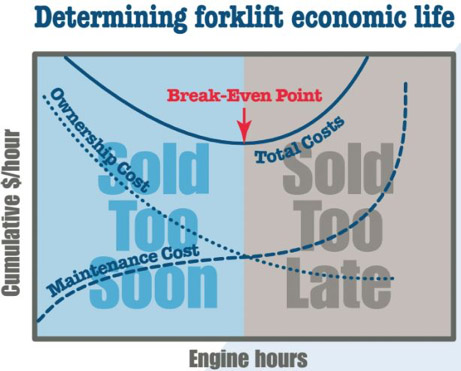How to Reduce Forklift Downtime
Guest blog by MHI member company, MCFA/Jungheinrich
Operating a forklift fleet in today’s business environment demands a focus on efficiency. There are basic practices any organization can follow in terms of operations and maintenance that can keep your downtime and repair costs to a minimum. Let’s take a look at some practices you can begin implementing immediately to reduce downtime.
Keep records and do the math. If you’re a sports fan you know that analytics and numbers have changed how teams are playing baseball, football and many other sports. Crunching numbers can also help you manage your fleet better. To calculate the ownership cost for each of your forklifts you need to keep detailed records for all of them individually. In your records you’ll want to keep track of critical items such as:
- • Purchase or lease price
- • Date obtained
- • Brand
- • Model number and serial number
- • Dates of all planned maintenance (PM) checkups and specific repairs
- • Engine hours
Keep your planned maintenance report sheets in the truck’s file so you have easy access to any repair trends or records of damage or abuse.
When you’re accurately tracking all of the information above you can then figure out the ownership cost for each forklift by finding the difference between the delivered cost and the residual value for the truck if you were to trade it in. Then, divide the ownership cost by the number of engine hours to find the lift truck’s cost per operating hour.
Example: A forklift costs $18,000 and has 10,000 engine hours. The trade in value is $8,000. The ownership cost is $18,000 – $8,000 = $10,000. The operating cost per hour is $10,000 / 10,000 hours = $1.00 per operating hour.
Another important equation to know is the maintenance cost per hour. To find the maintenance cost per hour, total up all the maintenance labor and material costs for the truck and divide it by the operating hours. So, if the truck in the previous example had $7,500 in maintenance and material costs over its lifespan, the maintenance cost per hour would be: $7,500 / 10,000 hours = $0.75 maintenance cost per hour.
Now, just add up the two equations to find out the hourly cost to operate and maintain the forklift. In the example above, this forklift costs $1.75 per hour to operate and maintain.
Replacing forklifts? Rely on your numbers. We just talked about math, and when it comes to making decisions on replacing forklifts, that math can help you make better financial decisions. While many businesses may make their replacement decisions based solely on the age of their forklifts, this is not the best way to make this decision. The chart below shows what’s known as the economic break-even point. This is the optimal time to replace a forklift, when its at its lowest total cost point. If you push much past that point, maintenance costs begin to rise and your expenses can become an issue.
Pick the right tool for the job. Many companies find that their business model changes, or their material handling needs change over the course of time. When this happens, forklift specifications also tend to change as well. In many warehouses, racks have become closer together and if an older truck isn’t designed with the necessary maneuverability it can really hamper productivity and efficiency. As your needs change, it’s important to pay attention to your fleet to make sure you’re matching the maneuverability and lift requirements for your present-day applications. Your local forklift dealer will be more than happy to assist you with an audit if you’d like some outside perspective on optimizing your fleet.
Don’t fall behind on planned maintenance. Each forklift should already come with an operating and maintenance manual. If for some reason it gets misplaced, your dealer can locate one for you. In your manual you’ll find a maintenance schedule that includes the planned service intervals. Just like your car needs regular oil changes and maintenance, your forklifts need planned maintenance. These routines are set at intervals to catch small problems before they become big problems which will help you both reduce downtime and operating costs.
Keep your facilities in order and train your operators. Beyond maintenance and selection, there are a couple of ways to help keep your forklifts operating at peak performance. One is to keep your facility clean and organized. Excess dirt and debris can impact your forklift’s systems and components and lead to easily avoidable repairs. The second is to make sure your operators are up to date on their training. While training is required in the United States and in Canada, many operators may be rusty on best practices or company policy. It’s also important that operators are knowledgeable about, and perform, their pre-shift forklift inspections so they can identify issues that could be potentially safety related or end up costing you more money. Keeping tabs on your operators and their safe operating practices can help you identify employees that need refresher training to make sure they’re operating the equipment safely and efficiently.
Don’t be afraid to ask for help. There are a lot of ways that you can help cut down on downtime, but if it seems overwhelming you can always get help. Your local forklift dealership can give you a hand with everything from record keeping to operator training and maintenance programs. If you’re not sure where to start, contact them and ask for an audit to help you get the ball rolling.






